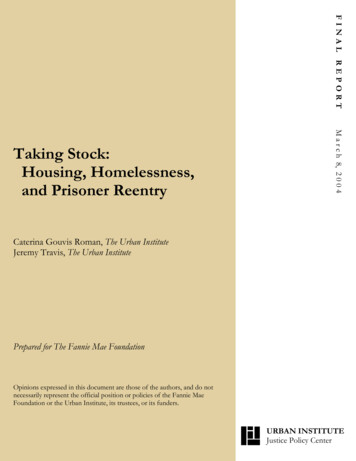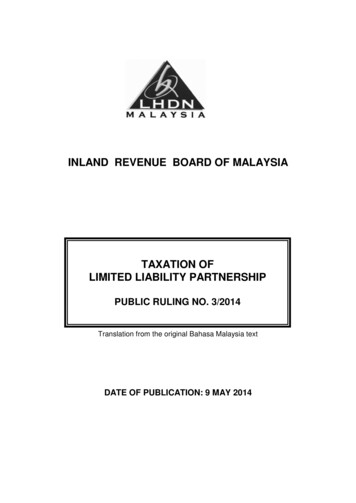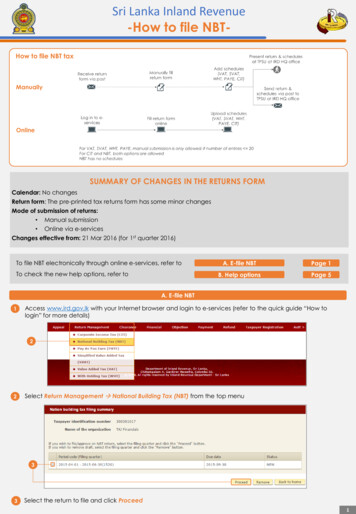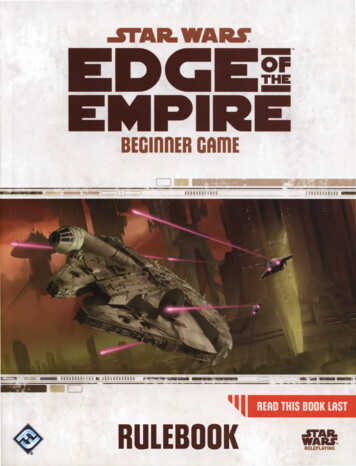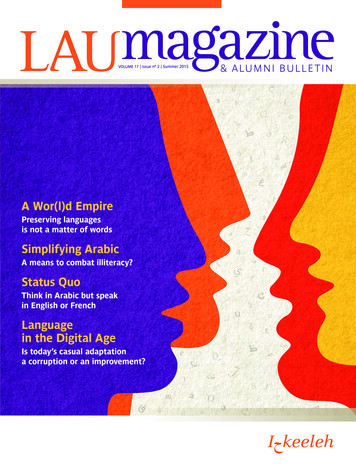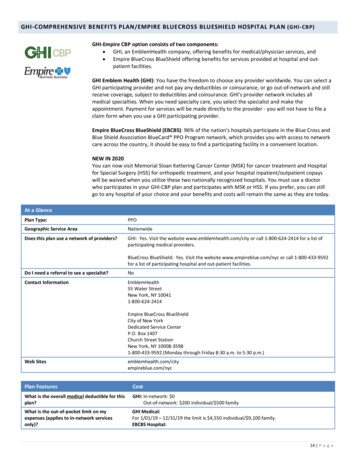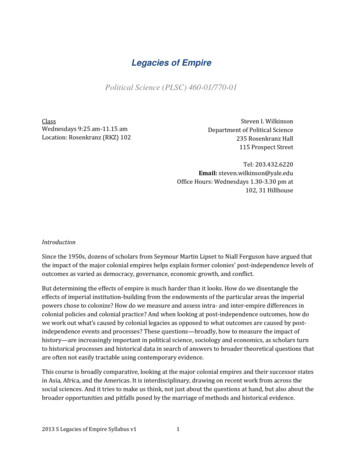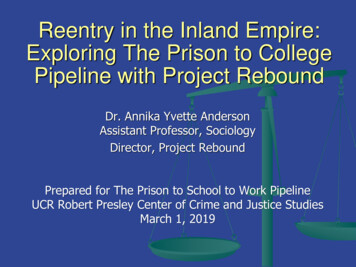
Transcription
Reentry in the Inland Empire:Exploring The Prison to CollegePipeline with Project ReboundDr. Annika Yvette AndersonAssistant Professor, SociologyDirector, Project ReboundPrepared for The Prison to School to Work PipelineUCR Robert Presley Center of Crime and Justice StudiesMarch 1, 2019
Introduction College education is one of themost effective ways to reducerecidivism and to increaseemployment and earnings forcriminal-justice involvedindividuals.The mission of the CSU ofproviding access to a qualityeducation to those who desire itand to change the lives of ourstudents and their families is inline with the goals of ProjectRebound.
Project Rebound: SFSU The late Professor John Irwin started Project Rebound in1967 as an on-campus reentry program for the formerlyincarcerated at San Francisco State University (SFSU).Project Rebound assists formerly incarcerated students toapply, enroll, and graduate with postsecondary degrees,and subsequently attain employment.Since 2005, 95 percent of Project Rebound’s students havesuccessfully earned postsecondary degrees from SF State.The program has helped hundreds of formerly incarceratedindividuals with over 300 students attaining undergraduateand graduate degrees.
Project Rebound: Expansion Due to its success, the CSU Chancellor’s office supported thedevelopment of Project Rebound programs at all CSU campuses.In 2016, The Opportunity Institute awarded 500,000 to pilot astatewide network of eight campus-based reentry programs,over three years.The pilot sites include: California State Polytechnic University, PomonaCalifornia State University, BakersfieldCalifornia State University, FresnoCalifornia State University, FullertonCalifornia State University, Los AngelesCalifornia State University, SacramentoCalifornia State University, San BernardinoSan Diego State University
Statement of Need The Opportunity Institute grant funding for CSUProject Rebound will end on June 30, 2019.Project Rebound was written into the 2019-2020state budget that Governor Newsom just released( 250,000).We seek to quadruple the state allotment to supportthe currently functioning 9 campuses and thecampuses waiting to be involved in the consortium.
Project Rebound: CSUSB The CSUSB team consists of a director andan assistant director, who both have teachingand/or research interests in reentry.One full-time coordinator and an intern, bothwith prior incarceration experiences, staff theprogram.The program coordinator acts as a liaisonand advocate with campus and communityprograms.
Enrollment Process Prospective students complete a questionnairewhich staff use to conduct an initial assessment ofeligibility.Based on the questionnaire, the coordinator: requests an evaluation of the student’stranscripts advise the student whether or not communitycollege preparation classes are needed help with the application if the student is readyto apply to CSUSB.
Student Support Strategies Once students are enrolled, Project Reboundstaff reviews and monitors their progresseach academic term and provide casemanagement services.Services include: financial support for educational materialinformation and referral for on-campus resourcesinformation on work-study positions, paidinternships, job opportunitiesfinancial support to attend professionalconferences
Outreach Strategies We held several on-campus events including our annualorientation and a Yotie Talk.We are currently developing collaborative events with otherprograms as a result of our outreach efforts (e.g. Filmscreenings and guest speakers). We launched a website and a newsletter Our interns chartered an affiliated student club The School of Social Work developed an internship programfor Project Rebound.
Research Study We conducted research in order to develop a successfulreentry program that serves the needs of our students.The formerly incarcerated population has intersecting,disadvantaged identities that require referrals to multipleservices and agencies (Anderson, Nava & Cortez, 2018).Few studies have examined the attitudes or perceptions offormer prisoners regarding successful reentry into theircommunities (Middlemass, 2017; Trimbur, 2009).Few studies have examined campus-based reentryprograms, specifically in the Southern California context.
Research Study Research questions: 1) what does a successful reentry program look like, and 2) what interventions aremost correlated with success?Sociodemographic information was collected from 18of the 21 current Project Rebound participants (86%participation rate) between September 2017 andFebruary 2018 using pre-existing program case files.Participants were also invited to participate in oralinterviews. Thirteen of the 21 Project Reboundparticipants completed these interviews (62%participation rate).
Demographic CharacteristicsVariableAge31-4041-5051-6061 GenderMaleFemaleEthnicityBlack/ African AmericanHispanicNative AmericanWhiteMarital StatusNot MarriedMarriedHousingFamilyRentOwnCommunal LivingHomelessEmployment StatusWorkingNot WorkingChildrenAt least one childNo .7%
Criminal HistoryVariableMeanAge of first Arrest19.9Number of ArrestsStandard mber of Violations1.72.20.07.0Number of years Incarcerated5.74.60.015.0
Participation in Campus ProgramsVariablesFrequencyPercentServices for Students with Disabilities527.8%Career Center527.8%Vocational Rehab422.2%Student Assistance in Learning (SAIL)422.2%Psychological Counseling316.7%First People’s Center for Indigenous Students211.1%The Den (Food Assistance Program)211.1%Veterans Success Center211.1%Workability15.6%Other Programs15.6%
Student Perceptions of ProgramProgram StrengthsVariablesFrequencyPercentBooks/ Supplies1292.3%Relationships with Project Rebound staff861.5%Informational Meetings646.2%FrequencyPercentBigger office space1292.3%More interaction with Project Rebound Students1076.9%Benefits towards education (computer use, parking pass, reduced fees)969.2%Maintaining privacy754.0%Areas for ImprovementVariablesNote: Data from interviews of 13 participants
Publications/Conferences “Project Rebound: Expanding the Prison to College Pipeline.”Presentation at the Annual Meeting of the American Society ofCriminology, Philadelphia, PA, November 2017.“Building Bridges through Prison-University Partnerships.”Presentation at the Annual Meeting of the American Society ofCriminology, Atlanta, GA, November 2018.“The Conduits to Reentry in the Inland Empire: Exploring thePrison to College Pipeline with Project Rebound” in ReturningHome: Prisoner Reentry in the 21st Century: CriticalPerspectives of Returning Home, edited by CalvinJohn Smileyand Keesha Middlemass. New York: Routledge.Two students presented at The 2018 Social Justice ResearchSymposium at University of California, Irvine.
Participant AccomplishmentsAs of the end of Spring 2018 Quarter: 21 current students were enrolled in our program. 4 students graduated with bachelor’s degrees. 7 students graduated with master’s degrees 4 students were accepted into graduate programs 1 student had a real-estate license re-issued
Student Testimonial Over the last few years I have enjoyed being a part of Project Rebound onour campus. In 2014 I graduated with both of my Bachelor’s Degrees, onein Social Sciences and one in Anthropology. Since then I have finished aMasters Degree in Social Sciences and Globalization and I am almostfinished with a 2nd advanced degree that is a Masters of PublicAdministration.Currently I am working on my PhD at Claremont Graduate University. Thisdegree is in Cultural Studies with a Concentration on Hemispheric andTransnational Studies. I look forward to writing my dissertation on theeducational aspect of mass incarceration and the Prison Industrial Complexin the State of California.I am currently working as an adjunct professor at California State Universityat San Bernardino where I am able to teach subjects related to EthnicStudies, Race and Racism, and Chicano Studies, that I feel are essential tothe success of our students. Project Rebound offers support,encouragement, and opportunities to advance education and succeed at theuniversity level.- Charlene Eaton
Current and Pending EnrollmentAs of the end of the Fall 2018 Quarter: 17 current students have enrolled in our program. 6 individuals enrolled in the Fall 2019 quarter.23 students are completing courses at thecommunity colleges, required for transfer into theuniversity.32 inmates have sent us transcripts, in preparationto join our program upon their release.
Long-term Goals Identify felon-friendly jobs andsocial/professional events on campusIdentify the gaps in service and thendevelop resources to fill the gapsDevelop faculty and student mentoringprograms for PR students
Long-term Goals Conduct additional research on theprogramWrite grants to help incoming studentstake courses through Extended Educationand/or Community CollegesDevelop social and professional growthopportunities (including scholarships)
Contact Information California State University, San Bernardino5500 University ParkwaySan Bernardino, CA 92407Office: FOB-242Phone: (909) 537-4351paul.jones@csusb.eduWebsite: https://www.csusb.edu/projectrebound
Project Rebound: CSUSB The CSUSB team consists of a director and an assistant director, who both have teaching and/or research interests in reentry. One full-time coordinator and an intern, both with prior incarceration experiences, staff the program. The program coordinator acts as a
